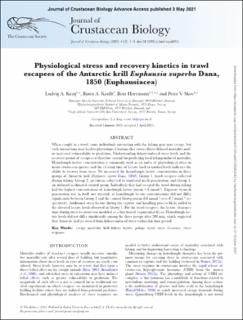| dc.description.abstract | When caught in a trawl, some individuals interacting with the fishing gear may escape, but such interactions may lead to physiological trauma that causes direct delayed mortality and/or increased vulnerability to predation. Understanding fishery-induced stress levels and the recovery period of escapees is therefore crucial for predicting total fishing-induced mortality. Hemolymph lactate concentration is commonly used as an index of physiological stress in many crustacean species, and the clearing time of lactate back to normal levels indicates the ability to recover from stress. We measured the hemolymph lactate concentration in three groups of Antarctic krill (Euphausia superbaDana, 1850): Group 1, trawl escapees collected during fishing; Group 2, specimens subjected to simulated mesh penetration; and Group 3, an onboard acclimated control group. Individuals that had escaped the trawl during fishing had the highest concentrations of hemolymph lactate (mean > 6 mmol–l). Exposure to mesh penetration was in itself not stressful, as hemolymph lactate concentrations did not differ significantly between Group 2 and the control Group (mean 0.8 mmol–lversus 0.7 mmol–l, respectively). Additional stress factors during the capture and handling process likely added to the elevated lactate levels observed in Group 1. For the trawl escapees, the lactate clearance time during stress recovery was modeled as a function of exponential decay. Hemolymph lactate levels did not differ significantly among the three groups after 200 min, which suggested that Antarctic krill recovered from fishery-induced stress within this time period. | |
